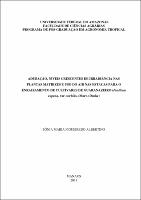| ???jsp.display-item.social.title??? |


|
Please use this identifier to cite or link to this item:
https://tede.ufam.edu.br/handle/tede/3049| ???metadata.dc.type???: | Tese |
| Title: | Adubação, níveis crescentes de irradiância nas plantas matrizes e uso do aib nas estacas para o enraizamento de cultivares de guaranazeiro (paullinia cupana, var. sorbilis, (mart.) ducke) |
| Other Titles: | Fertilization, increasing levels of irradiance and IBA on rooting cultivars of guarana (Paullinia cupana var. Sorbilis (Mart.) Ducke) |
| ???metadata.dc.creator???: | Albertino, Sônia Maria Figueiredo  |
| ???metadata.dc.contributor.advisor1???: | Silva, José Ferreira da |
| ???metadata.dc.description.resumo???: | guaranazeiro (Paullinia cupana var. sorbilis (Mart.) Ducke) é uma cultura de grande interesse para a região Amazônica, mas sua produtividade é ainda baixa. A disponibilidade de material vegetal geneticamente uniforme, precoce e produtivo é fundamental para a expansão e melhoria da cultura na região. Para isso, recomenda-se a propagação vegetativa, no entanto algumas cultivares apresentam problemas de enraizamento. Esse trabalho teve como objetivo avaliar o enraizamento de estacas de guaranazeiro provenientes de plantas adubadas e não adubadas, submetidas à níveis crescentes de irradiância, com e sem aplicação de AIB e, correlacionar as reservas dos ramos e das estacas com as características de enraizamento. O delineamento adotado foi inteiramente casualizado, em arranjo fatorial de 6x4x2x2. Os fatores estudados foram: cinco cultivares e um genótipo de guaranazeiro, quatro níveis de irradiância, presença e ausência de adubação e aplicação ou não de AIB. A unidade experimental continha 10 estacas com 4 repetições. As plantas matrizes receberam ou não adubação, no campo, durante dez anos e foram submetidas a níveis crescentes de irradiância por 60 dias. As estacas foram retiradas dessas plantas e permaneceram em viveiro por 120 dias para enraizamento. Após este período foram avaliados o número de estacas enraizadas, com calos e mortas, número de raiz, volume, comprimento e peso da matéria seca das raízes. Os teores de carboidratos foram determinados nos ramos e nas estacas enraizadas no momento do desmonte da pesquisa. O enraizamento das estacas foi maior no tratamento com adubação para as cultivares BRS-Maués, CMU 381 e BRS-CG 882. A redução da irradiância sobre as plantas matrizes favoreceu o enraizamento. O maior percentual de enraizamento e o menor de mortalidade das estacas foram obtidos no tratamento sem AIB, independente, da cultivar. A cv. BRS-Maués expressou o maior potencial de enraizamento, enquanto BRS-CG882 apresentou o menor enraizamento de estacas. BRS-Maués foi mais eficiente em acumular amido que a BRS-CG 882 e o potencial de enraizamento das duas cultivares apresentou correlação positiva com o teor de amido acumulado em cada uma. Quanto aos açúcares solúveis totais nos ramos, para BRS-CG 882 não houve correlação e para BRS-Maués foi negativa em relação ao enraizamento dessas duas cultivares. Palavras-chave: Propagação vegetativa, estaquia, sombreamento, fitohormônio, carboidratos. |
| Abstract: | Although guarana (Paullinia cupana var. Sorbilis (Mart.) Ducke) is a culture of great interest to the Amazon region, its productivity is still low. The availability of plant material that is genetically uniform, precocious and productive is the key for expanding and improving the culture in the region. To achieve this, it is recommended to do vegetative propagation, although some cultivars have rooting problems. This study aimed to evaluate the rooting of guarana from fertilized and unfertilized plants submitted to increasing levels of irradiance, with and without application of IBA. It also aimed to correlate the reserves of the branches and cuttings with rooting characteristics. The design was completely randomized in factorial arrangement of 6x4x2x2. The factors studied were the following: (i) five cultivars and one genotype of guarana, (ii) four levels of irradiance, (iii) with and without fertilization and (iv) application of IBA or not. The experimental unit contained 10 cuttings with four repetitions. The mother plants received or did not received fertilizer in the field for ten years and were subjected to increasing levels of irradiance for 60 days. The cuttings were taken from these plants and remained in the nursery for 120 days for rooting. After this period we evaluated the number of rooted cuttings with calluses and dead, root number, volume, length and dry weight of roots. The carbohydrate content was determined from the branches and rooted cuttings at the time of the dismantling of the research. The rooting of cuttings was higher for the fertilization treatment for BRS-Maues, CMU-CG 381 and BRS 882. The reduction of irradiance on the mother plant favored rooting. The highest percentage of rooting and lower mortality were obtained from cuttings without IBA treatment, independently of cultivar. The cv. BRS-Maués showed the highest rooting potential, while BRS-CG882 had the lowest rooting. BRS-Maués was more efficient in accumulating starch than the BRS- 882 CG and the rooting potential of both cultivars was positively correlated with the starch accumulated in each one. Regarding the total soluble sugars in the branches, there was no correlation for BRS-882 CG. For BRS-Maués the correlation was negative in relation to rooting of these twocultivars. |
| Keywords: | Propagação vegetativa Estaquia Sombreamento Fitohormônio Carboidratos Vegetative propagation Outtings Shading Phytohormone carbohydrates |
| ???metadata.dc.subject.cnpq???: | CIÊNCIAS AGRÁRIAS: AGRONOMIA |
| Language: | por |
| ???metadata.dc.publisher.country???: | BR |
| Publisher: | Universidade Federal do Amazonas |
| ???metadata.dc.publisher.initials???: | UFAM |
| ???metadata.dc.publisher.department???: | Faculdade de Ciências Agrárias |
| ???metadata.dc.publisher.program???: | Programa de Pós-graduação em Agronomia Tropical |
| Citation: | ALBERTINO, Sônia Maria Figueiredo. Fertilization, increasing levels of irradiance and IBA on rooting cultivars of guarana (Paullinia cupana var. Sorbilis (Mart.) Ducke). 2011. 109 f. Tese (Doutorado em Agronomia Tropical) - Universidade Federal do Amazonas, Manaus, 2011. |
| ???metadata.dc.rights???: | Acesso Aberto |
| URI: | http://tede.ufam.edu.br/handle/tede/3049 |
| Issue Date: | 31-Oct-2011 |
| Appears in Collections: | Doutorado em Agronomia Tropical |
Files in This Item:
| File | Description | Size | Format | |
|---|---|---|---|---|
| Tese Sonia.pdf | 1.03 MB | Adobe PDF |  Download/Open Preview |
Items in DSpace are protected by copyright, with all rights reserved, unless otherwise indicated.




